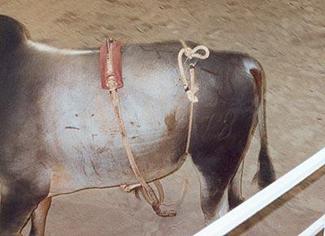
In October 2006, the Professional Bull Riders (PBR) brought a two day rodeo event to Exhibition Park in Halifax, Nova Scotia. This marked the first time an event of this kind had ever been held in Halifax. The purpose of the event was for cowboys to try to remain on the backs of frightened, stressed and goaded bucking bulls for up to 8 seconds. But what some see as an amusing show is no more then animal abuse for the sake of human entertainment. Tools and Methods Used to Irritate, Distress and/or Inflict Pain : The Flank Strap - This is a strap that goes around the flank, which is the fleshed area (I.e. the tender area with no boney protection) between the bulls last ribs and hip. The flank strap is pulled extremely tight by a rodeo hand standing above the chute just as the bull exits. The result is that the bull is so distressed and discomforted by the strap that he bucks to get the strap and rider off. |
|||
 |
The Electric Prod - Bull riders claim that electric prods are used only to move animals into the chutes if at all and are never used to chock the animals into performing. However, observers at the Exhibition Park Rodeo as well as other areas, witnessed many bulls receiving a jab with the electric prod as they left the chute. Such a prod delivers 5000—6000 volts of electricity, each time. Picture: Scarring shown on the side of a bull from the flank strap and spurs of the cowboy. |
||
Tail Twisting - During the Halifax performance, bulls’ tails were twisted in the chute before the animals were released in the arena with the rider on their backs. The tail is an extension of the vertebral chord in bulls, and is therefore a quite sensitive part of the animal. Spurs - PBR says that “The spurs help a rider maintain his balance by giving him added grip with his feet. The spurs do not cut or scratch a bull’s hide, which is seven times thicker than a human’s skin.” Cattle can feel flies land on them, so thickness of skin certainly does not denote non-sensitivity. The pain caused by the metal spurs landing on the shoulders and belly of the bull cannot be avoided and bruising will result. The quick, jolting and irregular movements of the bucking animal leave little opportunity for the rider to control the use of the spurs. As part of the scoring system, the rider gets points for a good raking with his feet/spurs. The rider’s goal is to kick continually the animal with the spurs. Animal Injuries and Deaths - Rodeo defenders boast about the dangerousness of their “sport” by emphasizing the bull rider’s risk of broken bones and other injuries. They attend rodeos with casts and neck collars. But, the cowboys, who choose to be there, are not the only ones who are injured. Indeed, the tools and methods cause the bulls to buck more violently and higher than they naturally would and many more times in a row. This renders them very susceptible to injuries. Bulls have been noticed to lose their balance, twisting, tripping and even falling down. It is also worth noting that once the rider fell off, any bull that tried to “fight back” was tormented by people dressed as clowns, and chased and roped by a man on horseback. FIGHT BACK! ASAP held lengthy protests at the October 6 and 7th 2006 rodeo, as well as the October 4 & 5th 2007 Rodeo, with the message that this kind of entertainment is nothing but animal abuse. Television (CTV) and newspapers (Daily News and Chronicle Herald) reported our concerns. If you would like to sign our petition demanding a complete ban of rodeo events in HRM, please email us. |
|||
|
|||